1998 - Sri Lanka - 200 rupee Polymer note
50th Independence Anniversary
To commemorate the 50th Anniversary of Sri Lanka regaining
Independence and a polymer two hundred rupee note was issued
on 1998, February, 4th together with three commemorative coins;
a five thousand rupee gold coin,
a one thousand rupee silver coin,
a ten rupee bi-metallic coin.
| Predominant Color | : Blue | |
| Size | : 146 x 74 mm
| Substrate | : Guardian®
|
| Serial Prefix | : N | |
| Replacement Prefix | : None
|
| Florescent Fiber | : | |
| Braille | : Embossed
|
| Mintage | : 20,559,000 | |
| Slabs | : 350
| Folders (Red) | : 100,000
|
| Range of Serial # | : N/1 000001 - N/22 5xx000
|
| Printer | : Note Printing Australia Limited
|
Front: Landscape Progress during 50 years of Independence
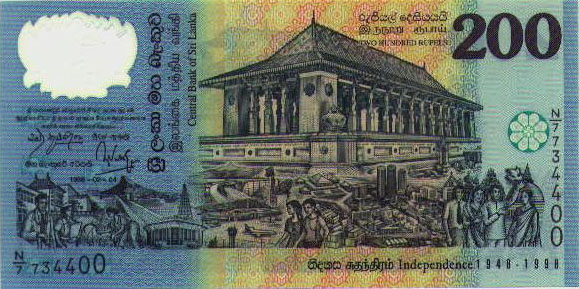
Click to see Red faded to Orange Serials N/1 000410 and N/1 128027
An Artist's impression of Independence Hall in Colombo
From left to right along a panel at lower third of note
- Free education and health services
- Gal Oya development project
- Electricity development
- Bandaranaike Memorial International Conference Hall
- Mahaweli development project
- Bandaranaike International Airport
- Telecommunications development
- Investment Promotion Zone
- New parliament complex of Sri Jayewardenepura, Kotte
- Industrial development
- Development of the Colombo city and the port
- Unity and peace
Bottom right in single line with same font size
නිදහස in Sinhala,
சுதந்திரம் in Thamil and
Independence 1948-1998 in English.
Numeric 200 in Upper right with to it's left value in 3 horizontal lines of same font size.
රුපියල් දෙසියයි in Sinhala,
இருநூறு ரூபாய் in Thamil
and TWO HUNDRED RUPEES in English.
Watermark window to upper left with to it's right Issue's name in 3 tilted vertical
lines of decreasing font size.
ශ්රී ලංකා මහ බැංකුව in Sinhala
இலங்கை மத்திய வங்கி in Thamil and
CENTRAL BANK OF SRI LANKA in English.
Legality Legend in 3 lines below watermark window on upper left
ශ්රී ලංකාණ්ඩුව වෙනුවෙන් නිකුත් කරන ලද මේ
මුදල් නෝට්ටුව ශ්රී ලංකාව ඇතුළත ඕනෑම මුදල් ගණනක්
ගෙවිම සඳහා නිතියෙන් වලංගුය
Below facsimile signature of C. B. Kumaratunga with
මුදල් ඈමති(Finance Minister) to left. and
මහ බැංකුවේ අධිපති(Central Bank Governor) with signature of A. S. Jayawardena to right.
Date 1998-02-04 below.
Size of digits in serial number increase in size.
Black Serial number Horizontal at lower left and vertical on lower right.
Back: Landscape The National Heritage
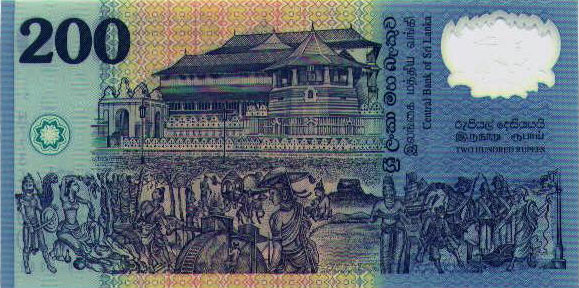 An Artist's impression of Sri Dalada Maligawa(Temple of the Tooth Relic & Octogon)
in Kandy
An Artist's impression of Sri Dalada Maligawa(Temple of the Tooth Relic & Octogon)
in Kandy
From left to right along a panel at lower third of note
- Advent of Prince Vijaya (5th Century BCE)
- Arrival of Arahant Mahinda and introduction of Buddhism during
the reign of King Devanampiyatissa (248 BCE)
- King Dutugemunu unites Sri Lanka and pays respect to the enemy
King Elara and builds the Maha Seva (2nd Century BCE)
- King Kasyapa builds his palace at the Sigiriya rock fortress
and decorates it with frescoes (6th Century CE)
- King Parakramabahu the Great constructs the Sea of Parakrama
(12th Century CE)
- Invasion of Sri Lanka by the Portuguese (16th Century CE)
the Dutch (17th Century CE)
and conquest by the British (19th Century CE)
- Wariyapola Sri Sumangala Thero hauling down the British Flag
at the Kandyan convention (1815 CE)
Numeric 200 in Upper left.
Watermark window to upper right.
Below in 3 horizontal lines of same font size.
රුපියල් දෙසියයි in Sinhala,
இருநூறு ரூபாய் in Thamil
and TWO HUNDRED RUPEES in English.
To it's left Issue's name in 3 tilted vertical lines of decreasing font size,
ශ්රී ලංකා මහ බැංකුව in Sinhala
இலங்கை மத்திய வங்கி in Thamil and
CENTRAL BANK OF SRI LANKA in English.
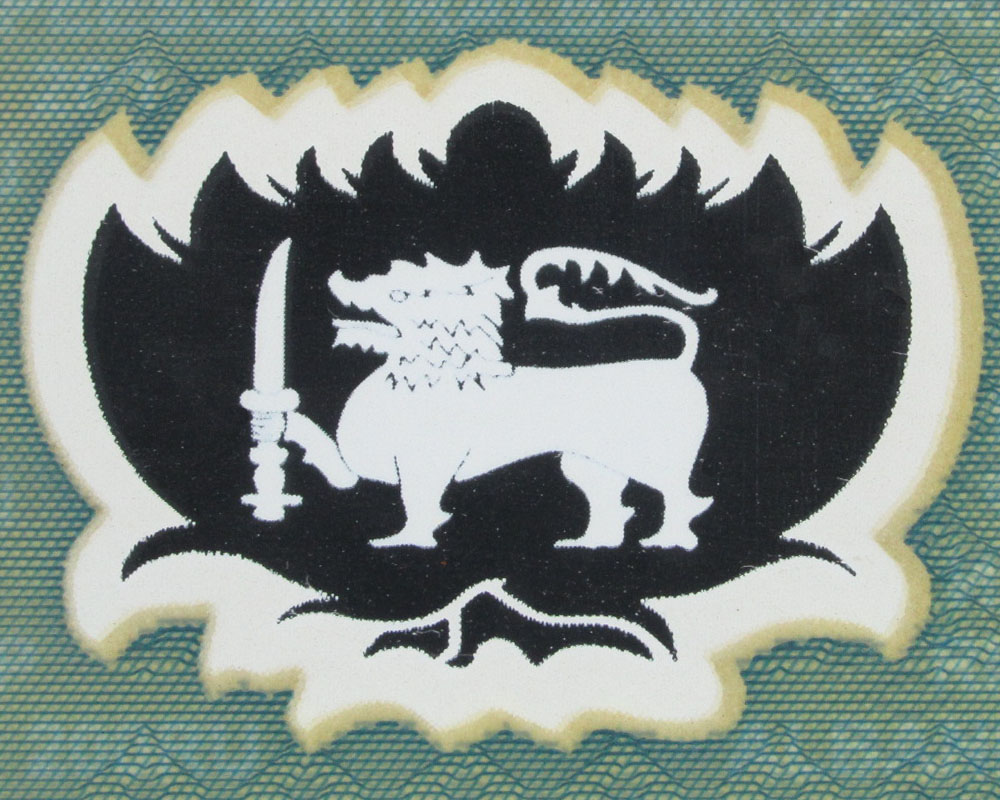 Watermark : In transparent window in the shape of a lotus viewed from side:
Standing Lion from National Flag, facing left, front right paw raised
with vertical sword.
Security :Just below the 200 on the upper right a much
smaller 200 with the Flag lion with sword on top of the 00.
See also design features printed on the white substrate of
note
Watermark : In transparent window in the shape of a lotus viewed from side:
Standing Lion from National Flag, facing left, front right paw raised
with vertical sword.
Security :Just below the 200 on the upper right a much
smaller 200 with the Flag lion with sword on top of the 00.
See also design features printed on the white substrate of
note
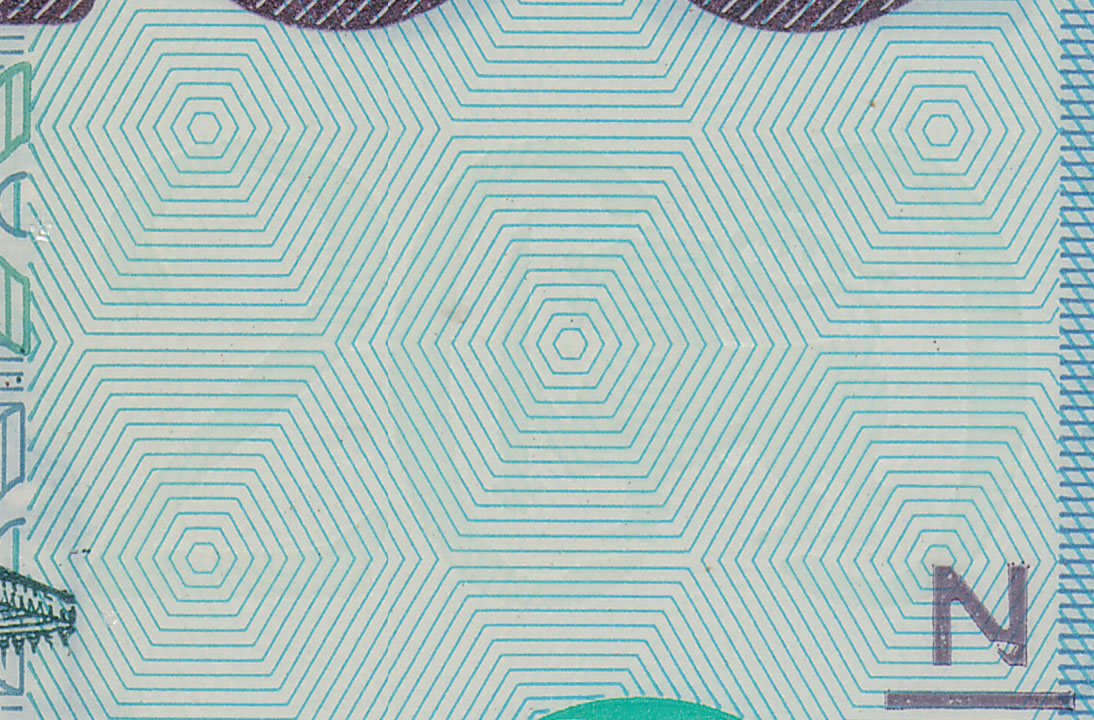 Latent image: At the upper right of front, below numeric 200,
the Numeric value 200 with the Flag Lion on the Zeros.
Advanced Latent image not clearly visible in 1200 dpi scan.
Click to see it highlighted by image processing.
You can also see Latent image with a bright light illuminating
the note from the back.
Latent image: At the upper right of front, below numeric 200,
the Numeric value 200 with the Flag Lion on the Zeros.
Advanced Latent image not clearly visible in 1200 dpi scan.
Click to see it highlighted by image processing.
You can also see Latent image with a bright light illuminating
the note from the back.
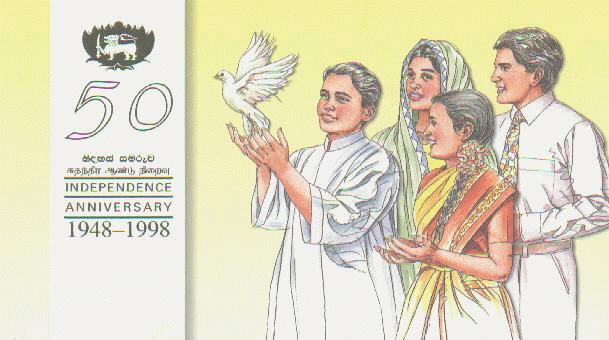 Unlike other currency notes of Sri Lanka which are produced on special
paper, this Rs 200 note to commemorate the regaining of independence
by Sri Lanka 50 years ago, is produced for the first time in polymer.
It was the 9th
country to issue an NPA based polymer note.
Unlike other currency notes of Sri Lanka which are produced on special
paper, this Rs 200 note to commemorate the regaining of independence
by Sri Lanka 50 years ago, is produced for the first time in polymer.
It was the 9th
country to issue an NPA based polymer note.
The note is legal tender in Sri Lanka. As a commemorative issue, only
a limited number of notes will be issued.
The artwork of the note has been done by Mr Ananda Somathilake and Mr
Gamini Mendis under the direction of Mr Albert Dharmasiri attached to
the Institute of Aesthetic Studies, University of Kelaniya.
Security Features of the Note
- Transparent window
- Translucent shadow image
- An artistic impression of the heraldic lion of Sri Lanka within a lotus design
- Micro printing
- Embossing of the '200' in Braille to be recognized by the visually impaired
- See through feature of the lotus flower
- Fluorescent features
The Rupees 200/- Polymer Currency note was produced by note printing
Australia. It was formed in 1996, as a joint venture between the
Reserve Bank of Australia (RBA), and Innovia Films.
Their roots are CSIRO which was formed in 1926 as an Australian
government for Scientific and Industrial Research Organization. CSIRO
played a major role in the creation of polymer banknotes, a revolution
in the world of banknotes that started in 1968, when the Reserve Bank
of Australia (RBA) requested a scientific solution to the problem of
forgery. CSIRO, RBA and the University of Melbourne joined their
knowledge, and in 1988 the first legal tender polymer note - the $10
aborginal Note of Australia.
In 2013 Innovia acquired RBA's 50% and in 2017 merged with Banknote
Corporation of America and rebranded as
CCL Secure
who now produces Guardian® substrate.
A triple fold
souvenir card with the note encased in a removable mount was
issued. The serial number of these notes are printed in red unlike
black used in the notes in general circulation. The issue price of the
souvenir card was Rs 400/- (US $6.25).
It was also sold in a
slab of acrylic with a issue
price of Rs 650/- (US $10). As 350 slabs were made, the Serail
N/1 000410 must be a very early red serial in note form.
Documents from CBSL state 100000 Notes with Red serial numbers in
Folders, and rest of 20 Million notes into circultion with Black
serial numbers. But they also give a total supplied of 20559K and a
final serial prefix of N/22. Serial Number N/1 000137 is as seen on
my slab and also N/1 000410, N/1 008888, and N/1 060810, N/1 128027 in my folders now 25
years later, appear Orange which probably implies that maybe the Red
fades to Orange. The Orange serial N/1 128027
indicating that more than 100,000 were printed not in Black.
I also have Red serial Number N/1 108020 probably takem out of
folder which has not faded.
There were no Replacement Notes. New Uncirculated Bundles from CBSL
had missing serial numbers. May explain why the last serial prefix is
given as N/22 while the number minted is given by CBSL as 20,559,000.
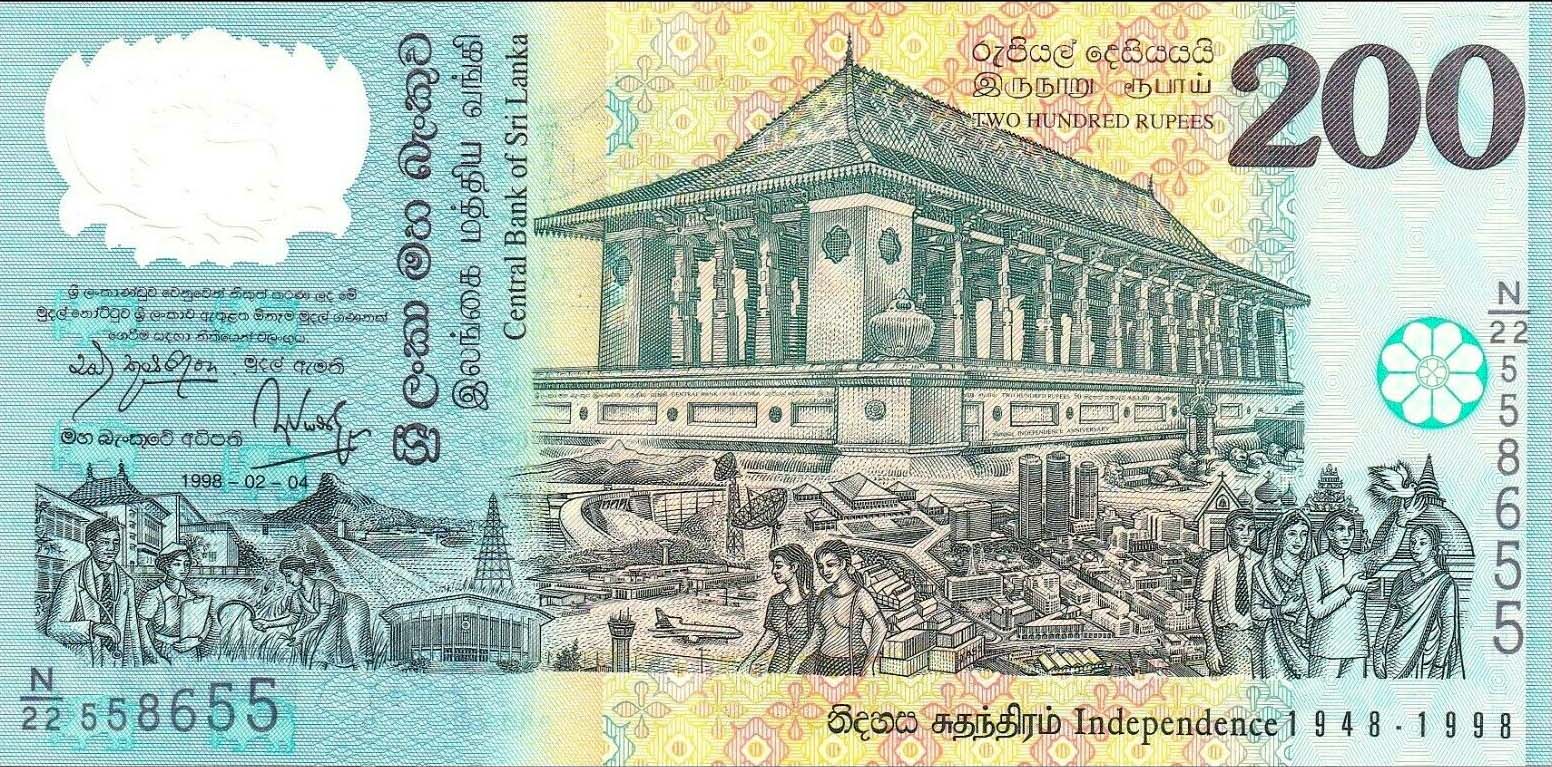 However the last Serial number being almost 10% more than the number
of polymer notes printed is like the damage rate with the introduction of
SNIM.
However the last Serial number being almost 10% more than the number
of polymer notes printed is like the damage rate with the introduction of
SNIM.
In Spink Auction 19023 166 a N/21 bundle of 100 was
sold. The difference between Last and First was 112 banknotes.
I have N/22 549445 and seen online N/22 558655. If you have a
higher number please send me image. (Maximum Needs to be found).
kavanr @ gmail.com
20 years later In 2018 Folders were still being sold from CBSL Museum
for Rs800 (US$5.30). The slab which I can remember refusing to buy from
CBSL a few years after issue, I was lucky to win at a SLNS meeting Auction
from Fred Medis. I was surprised to hear in 2020 that it has become a
rare collectible selling for more than US$200 in local Numismatic Market.
The note was scanned at 100 dpi and the images are displayed at 100 dpi.
The uncirculated note was obtained from the Central Bank of Sri Lanka.
The text on this page is edited from the commemorative souvenir card
which has the full description in all three languages Sinhala, Thamil
and English.
The Unity and Peace did not however arrive as hoped before the 50th
Anniversary, and the Sri Dalada Maligawa in Kandy illustrated on the reverse
was bombed by the LTTE terrorists a week before the celebrations.
The civil War only ended in 2009 May, for which the second commemorative
note was issued.
A Fake "error" note appeared for sale on eBay Auction in 2020 and is
discussed and illustrated.
See also Media Report
CDN 1998 02 06
For collected details of the images on this Banknote see
NotesCollector.



 Watermark : In transparent window in the shape of a lotus viewed from side:
Standing Lion from National Flag, facing left, front right paw raised
with vertical sword.
Security :Just below the 200 on the upper right a much
smaller 200 with the Flag lion with sword on top of the 00.
See also design features printed on the white substrate of
note
Watermark : In transparent window in the shape of a lotus viewed from side:
Standing Lion from National Flag, facing left, front right paw raised
with vertical sword.
Security :Just below the 200 on the upper right a much
smaller 200 with the Flag lion with sword on top of the 00.
See also design features printed on the white substrate of
note Latent image: At the upper right of front, below numeric 200,
the Numeric value 200 with the Flag Lion on the Zeros.
Advanced Latent image not clearly visible in 1200 dpi scan.
Click to see it highlighted by image processing.
You can also see Latent image with a bright light illuminating
the note from the back.
Latent image: At the upper right of front, below numeric 200,
the Numeric value 200 with the Flag Lion on the Zeros.
Advanced Latent image not clearly visible in 1200 dpi scan.
Click to see it highlighted by image processing.
You can also see Latent image with a bright light illuminating
the note from the back.

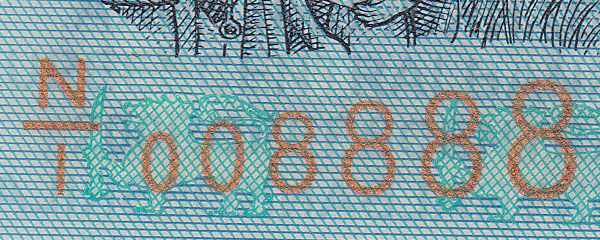



 However the last Serial number being almost 10% more than the number
of polymer notes printed is like the damage rate with the introduction of
SNIM.
However the last Serial number being almost 10% more than the number
of polymer notes printed is like the damage rate with the introduction of
SNIM.